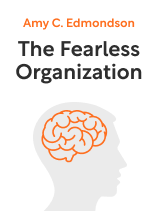

This article is an excerpt from the Shortform book guide to "The Fearless Organization" by Amy C. Edmondson. Shortform has the world's best summaries and analyses of books you should be reading.
Like this article? Sign up for a free trial here.
Is your business emotionally toxic? How do you create psychological safety in the workplace?
If workers are in bad moods or afraid to speak their truth at work, you might have a psychologically unsafe environment. Luckily, Amy C. Edmondson’s book The Fearless Organization says you can turn this around quickly.
Learn how to create psychological safety in the workplace in no time.
Practice 1: Reshape and Redefine Company Belief Systems
Edmondson says learning how to build psychological safety in the workplace begins with reshaping and redefining broadly understood, often long-held, sometimes deeply entrenched belief systems within organizations. It can be an arduous process that requires patience, particularly in companies where psychological safety hasn’t previously existed. Leaders have to work in consultation and collaboration with employees and other stakeholders to build trust—particularly with employees who have come to learn that engaging and speaking up will lead to repercussions, even when encouraged to do it.
(Shortform note: Experts say that a key to cultivating work cultures that make all employees feel safe to speak up is focusing on diversity in organizations and organizational leadership. They say that leaders must bring issues of inclusion into conversations about company strategies and practices and that managers should be encouraged, trained, and empowered to employ flexible, inclusive practices. Additionally, it helps if senior leaders are themselves diverse in visible and invisible ways.)
Practice 2: Redefine Failure
Redefining the purpose and value of failure can help employees view mistakes that they and others make not as problems to avoid at all costs and sweep under the rug, but as opportunities to improve their work and support their company in achieving its goals. Leaders can encourage employees to identify, address, and speak openly about mistakes and failure by redefining failure in the following ways:
1) Failure is a natural and valuable part of the learning process so long as you identify and analyze it after the fact to understand why things didn’t work, where they went wrong, and ways you can prevent the same problem from happening again.
2) Failure is a required part of experimental, investigatory, and exploratory processes that allow you to quickly move forward and figure out what solution works best.
3) Failure is a warning sign that can avert preventable problems and disasters.
Example: Google X Celebrates Failure
Edmondson writes that Google X, an innovation lab parented by Alphabet, celebrates failure as part of the natural path to success. X CEO, Astro Teller, says the company believes that people have to fail to take big risks that lead to big innovations, and the faster that teams fail, the more quickly innovation can begin. To reflect this belief, the company established a set of now culturally-embedded practices that make failing safe, such as awarding promotions and bonuses to teams when they fail and holding an annual memorial service for failed projects to allow employees to say final, parting words to prototypes that didn’t make it.
Practice 3: Encourage Employees to Speak Up
Edmondson says that leaders must create a safe space for employees to ask questions, engage in debate, and learn from one another. Building psychologically safe work cultures enables workers to tap into their creativity and innovate, which in turn improves their engagement and performance.
As a leader, you can encourage employees to speak up by modeling curiosity and humility, asking thoughtful questions, and putting structures in place that support your efforts to engage employees. This will bring workers into the fold, inspire them to replicate behavior you want to embed in your organizational culture, and foster employees’ belief that what they have to say is important.
(Shortform note: Experts say that creating a safe space isn’t the only thing you have to do to foster creativity and innovation. You must also provide basic support, direction, and parameters to keep employees from going off the rails; avoid micromanaging so you don’t stifle ideas; and level the idea-generation playing field for introverts and extroverts by encouraging workers to take time to themselves to identify new ideas.)

———End of Preview———
Like what you just read? Read the rest of the world's best book summary and analysis of Amy C. Edmondson's "The Fearless Organization" at Shortform.
Here's what you'll find in our full The Fearless Organization summary:
- The importance of psychological safety in the workplace
- How leaders and non-leaders can foster psychologically safe environments
- Why workers should be able to make mistakes without fear of reprisal






